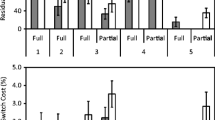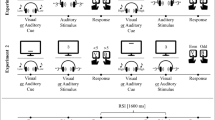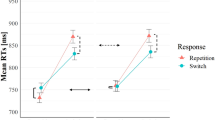Abstract
In the explicit cuing version of the task-switching paradigm, each individual task is indicated by a unique task cue. Consequently, a task switch is accompanied by a cue switch. Recently, it has been proposed that priming of cue encoding contributes to the empirically observed switch costs. This proposal was experimentally supported by using a 2:1 mapping of cues to tasks, so that a cue switch does not necessarily imply a task switch. The results indeed suggested a substantial contribution of “cue-switch costs” to task-switch costs. Here we argue that the 2:1 mapping potentially leads to an underestimation of “pure” task-switch costs. To support this argument, we report the results of a new study in which we used “transition cues” that indicate the identity of the current task based on the identity of the preceding task. This new type of cue allows a full factorial manipulation of cue switches and task switches because it includes the condition in which a cue repetition can also indicate a task switch (i.e., when the “switch” cue is repeated). We discuss the methodological implications and argue that the present approach has merits relative to the previously used 2:1 mapping of cues to tasks.


Similar content being viewed by others
References
Brass, M., & von Cramon, D. Y. (2004). Decomposing components of task preparation with functional magnetic resonance imaging. Journal of Cognitive Neuroscience, 16, 609–620.
Burgess, P. W. (2000). Strategy application disorder: The role of the frontal lobes in human multitasking. Psychological Research, 63, 279–288.
Fagot, C. (1994). Chronometric investigations of task switching. Unpublished Ph.D. thesis, University of California, San Diego.
Forstmann, B. U., Brass, M., Koch, I., & von Cramon, D. Y. (2005). Internally generated and directly cued task sets: An investigation with fMRI. Neuropsychologia, 43, 943–952.
Hübner, R., Futterer, T., & Steinhauser, M. (2001). On attentional control as source of residual shift costs: Evidence from two-component task shifts. Journal of Experimental Psychology: Learning, Memory, and Cognition, 27, 640–653.
Kleinsorge, T., & Heuer, H. (1999). Hierarchical switching in a multi-dimensional task space. Psychological Research, 62, 300–312.
Koch, I. (2003). The role of external cues for endogenous advance reconfiguration in task switching. Psychonomic Bulletin & Review, 10, 488–492.
Koch, I., & Allport, A. (2005). Cue-based preparation and stimulus-based priming of tasks in task switching. Memory & Cognition (in press).
Koch, I., Gade, M., & Philipp, A. (2004). Inhibition of response mode in task switching. Experimental Psychology, 51, 51–57.
Logan, G. D., & Bundesen, C. (2003). Clever homunculus: Is there an endogenous act of control in the explicit task-cuing procedure? Journal of Experimental Psychology: Human Perception and Performance, 29, 575–599.
Logan, G. D., & Bundesen, C. (2004). Very clever homunculus: Compound stimulus strategies for the explicit task cuing procedure. Psychonomic Bulletin & Review, 11, 832–840.
Mayr, U., & Keele, S. W. (2000). Changing internal constraints on action: The role of backward inhibition. Journal of Experimental Psychology: General, 129, 4–26.
Mayr, U., & Kliegl, R. (2003). Differential effects of cue changes and task changes on task-set selection costs. Journal of Experimental Psychology: Learning, Memory, and Cognition, 29, 362–372.
Meiran, N. (1996). Reconfiguration of processing mode prior to task performance. Journal of Experimental Psychology: Learning, Memory, and Cognition, 22, 1–20.
Meiran, N., Chorev, Z., & Sapir, A. (2000). Component processes in task switching. Cognitive Psychology, 41, 211–253.
Monsell, S. (2003). Task switching. Trends in Cognitive Science, 7, 134–140.
Oldfield, R. C. (1971). The assessment and analysis of handedness: The Edinburgh Inventory. Neuropsychologia, 9, 97–113.
Rogers, R. D., & Monsell, S. (1995). The cost of a predictable switch between simple cognitive tasks. Journal of Experimental Psychology: General, 124, 207–231.
Rubinstein, J., Meyer, D. E., & Evans, J. E. (2001). Executive control of cognitive processes in task switching. Journal of Experimental Psychology: Human Perception and Performance, 27, 763–797.
Rushworth, M. F. S., Hadland, K. A., Paus, T., & Sipila, P. K. (2002). Role of the human medial frontal cortex in task switching: A combined fMRI and TMS study. Journal of Neurophysiology, 87, 2577–2592.
Schuch, S., & Koch, I. (2003). The role of response selection for inhibition of task sets in task shifting. Journal of Experimental Psychology: Human Perception and Performance, 29, 92–105.
Schuch, S., & Koch, I. (2004). The costs of changing the representation of action: Response repetition and response–response compatibility in dual tasks. Journal of Experimental Psychology: Human Perception and Performance, 30, 566–582.
Sudevan, P., & Taylor, D. A. (1987). The cuing and priming of cognitive operations. Journal of Experimental Psychology: Human Perception and Performance, 13, 89–103
Acknowledgements
The authors would like to thank Jan Derrfuss and Uta Wolfensteller for many discussions as well as Ronald Hübner, Thomas Kleinsorge and an anonymous reviewer for helpful comments on a previous version of the article.
Author information
Authors and Affiliations
Corresponding author
Rights and permissions
About this article
Cite this article
Forstmann, B.U., Brass, M. & Koch, I. Methodological and empirical issues when dissociating cue-related from task-related processes in the explicit task-cuing procedure. Psychological Research 71, 393–400 (2007). https://doi.org/10.1007/s00426-005-0040-4
Received:
Accepted:
Published:
Issue Date:
DOI: https://doi.org/10.1007/s00426-005-0040-4




